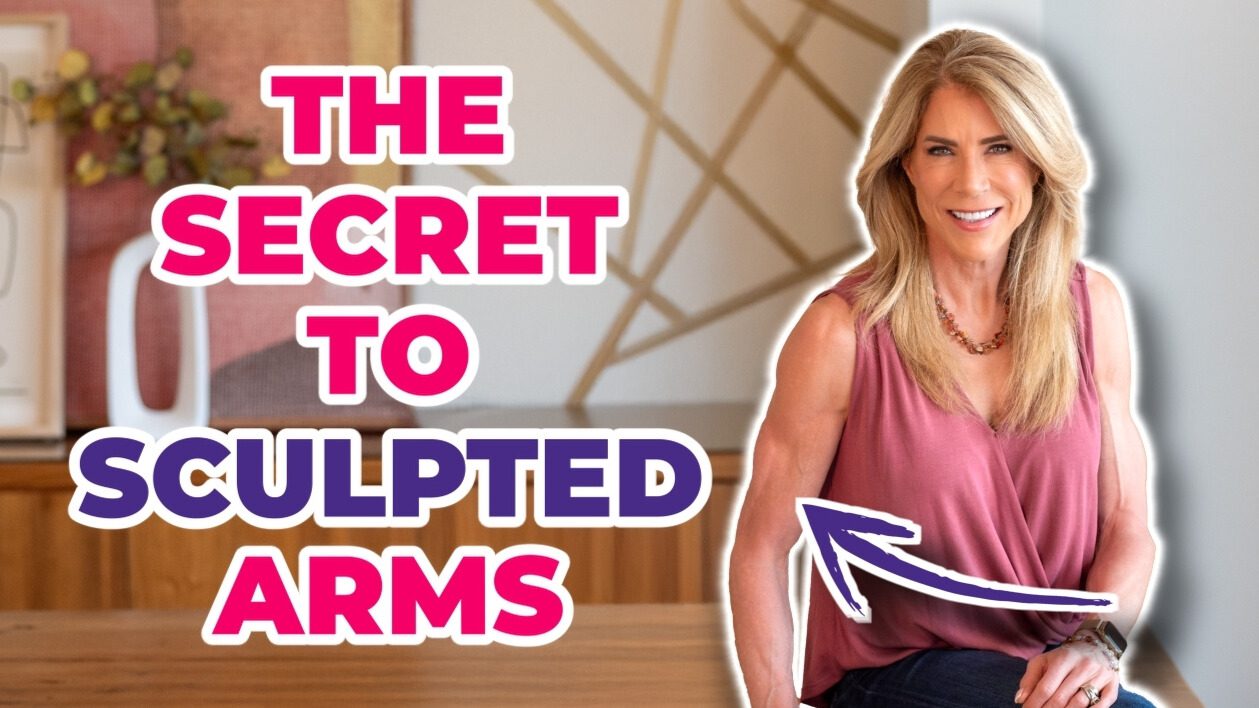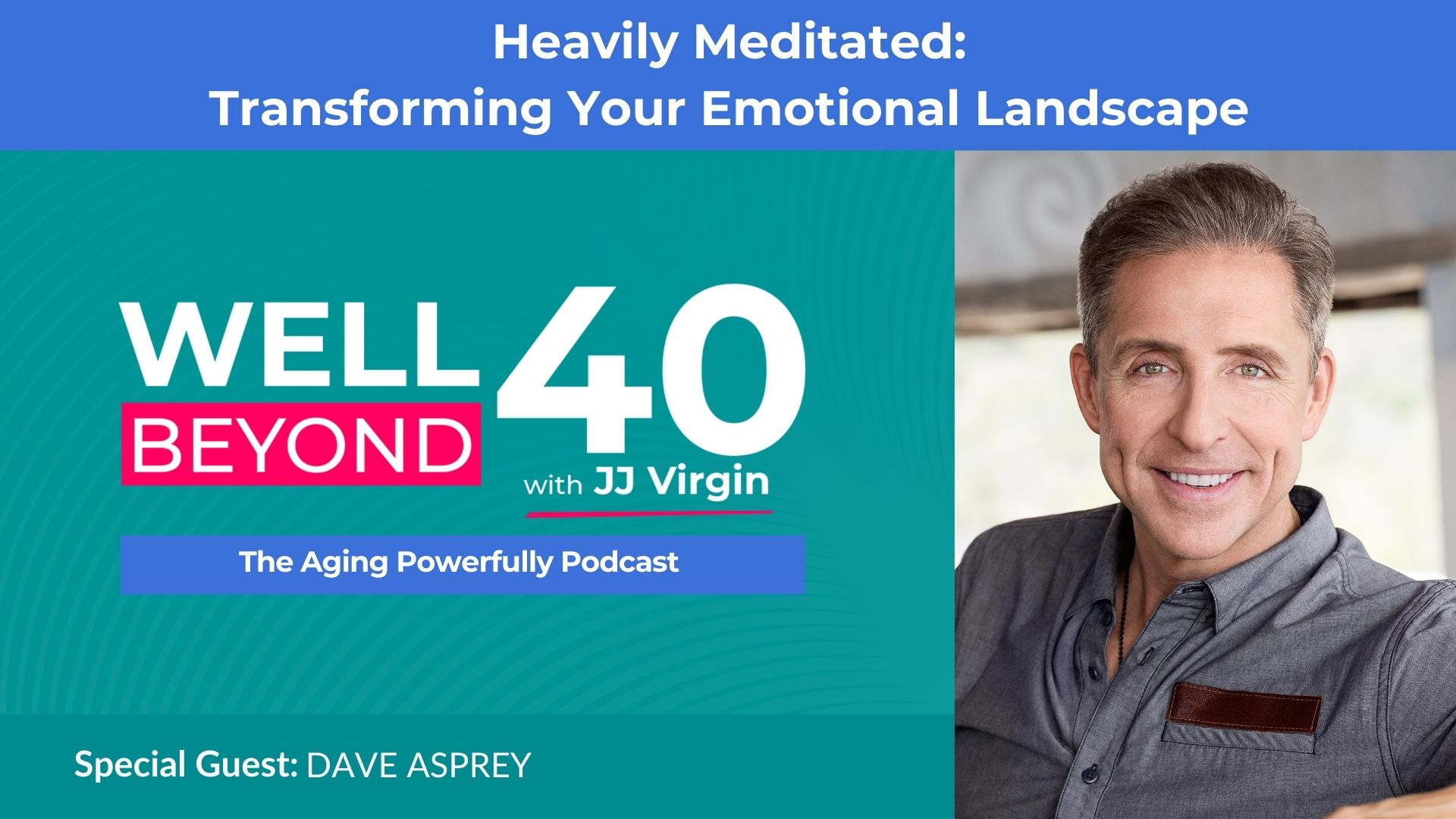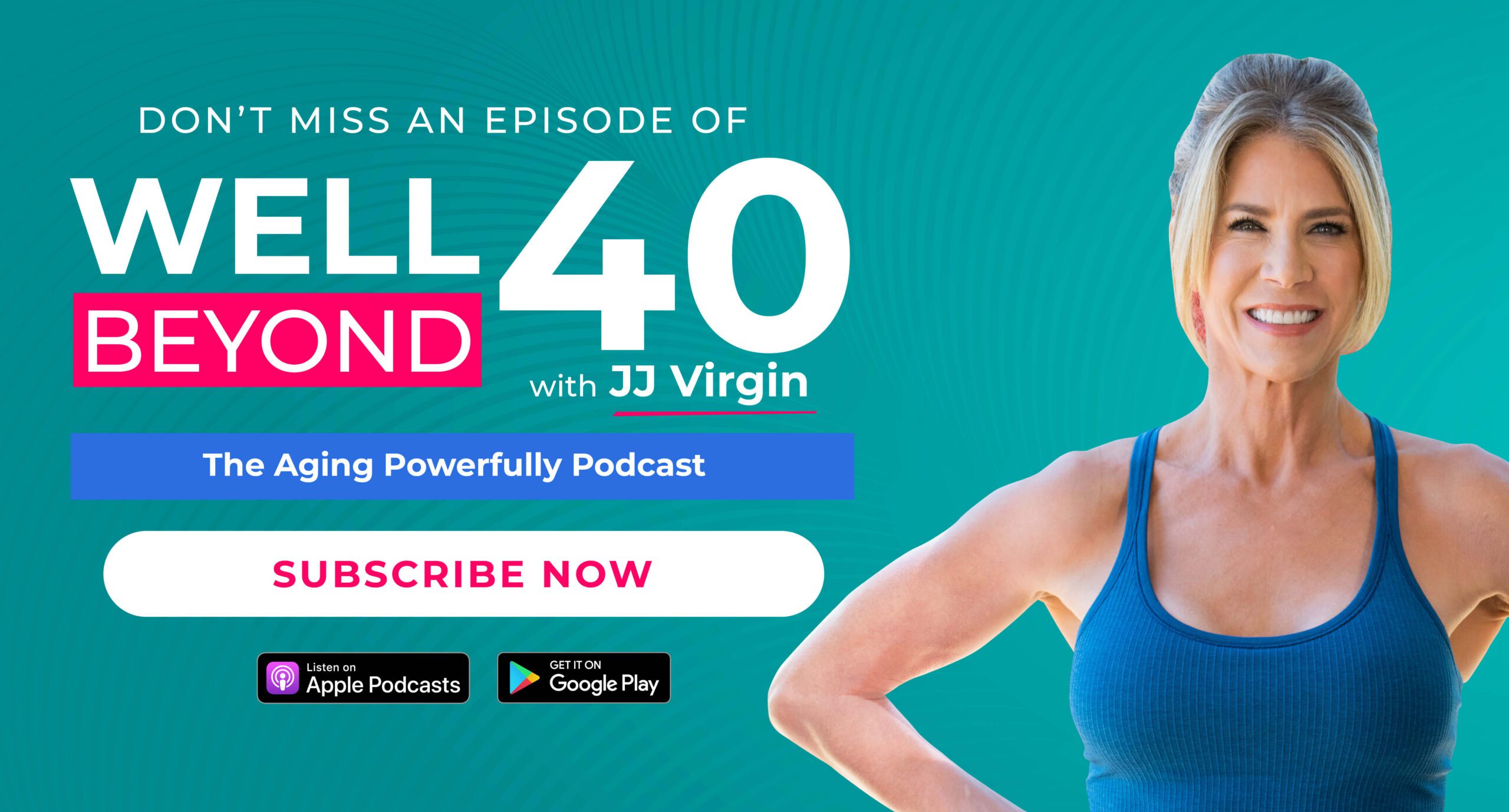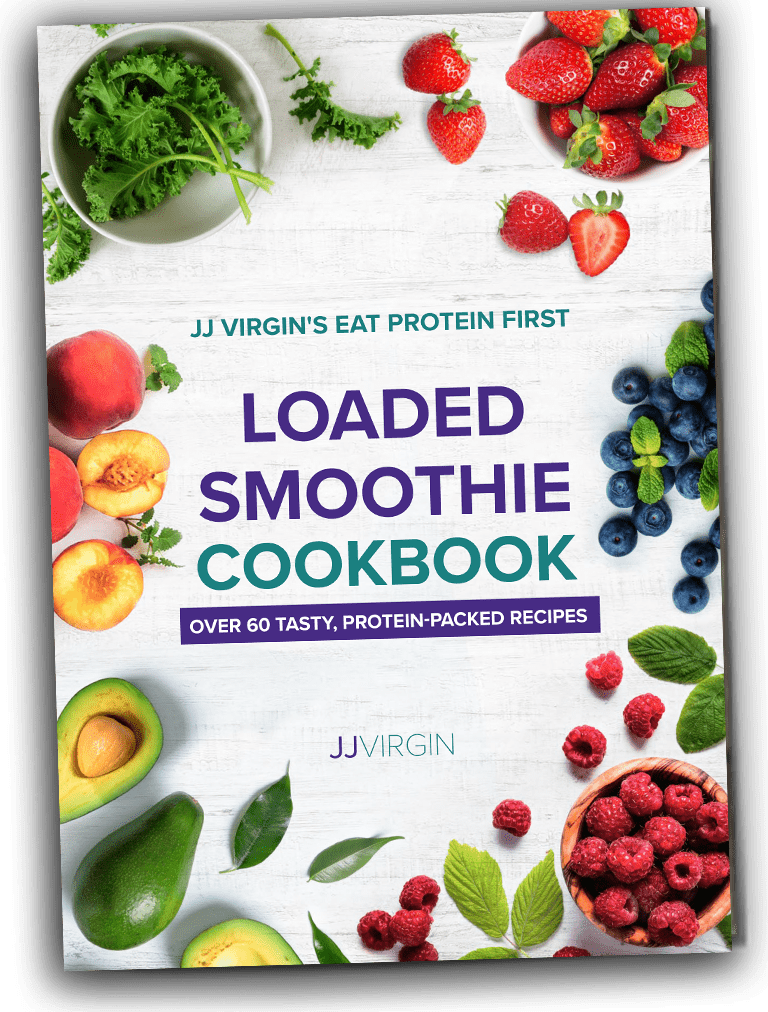The Roadmap to Sculpted, Strong Arms That Defy Age
Tossing aside those tiny pink dumbbells might be the best decision you make for your arms! After 40 years helping people transform their bodies, I’m sharing why those high-rep, low-weight workouts aren’t delivering the toned arms you want. True muscle definition comes from understanding what muscle tone actually is—a partial contraction that gives shape even at rest—and that requires stimulating real muscle growth with challenging weights. I break down exactly how many sets, reps, and what types of compound movements will transform your upper body, plus why concerns about getting “bulky” are completely unfounded (something I’ve literally never seen happen unless someone’s overeating and not exercising).
What you’ll learn:
- Why the “small weights, high reps” approach won’t give you the toned arms you want
- The truth about muscle tone and why you won’t get “bulky” from resistance training
- How compound movements are more effective than isolation exercises for defined arms
- The ideal protein intake and training frequency for visible arm definition
- The “vanity trio” of finishing exercises that can enhance your results
- Why resistance training benefits not just your muscles but also bone density and skin elasticity
- How to strategically build muscle first, then reduce body fat for maximum definition
Love the Podcast? Here’s what to do:
Make My Day & Share Your Thoughts!
- Subscribe to the podcast & leave me a review
- Text a screenshot to 813-565-2627
- Expect a personal reply because your voice is so important to me.
Join 50,000+ followers who make this podcast thrive.
Want to listen to the show completely ad-free?
- Go to subscribetojj.com
- Enjoy the VIP experience for just $4.99/month or $49.99/year (save 17%!)
- Click “TRY FREE” and start your ad-free journey today!
Resources Mentioned in this episode
Reignite Wellness™ Collagen Peptides Powder
Reignite Wellness™ Magnesium Body Calm
Download my free Resistance Training Cheat Sheet
Episode Sponsors:
Try Timeline. Use code JJ10 for 10% off all products
Try Qualia risk free for up to 100 days and code VIRGINWELLNESS for an additional 15% off
Air Doctor: get up to $300 off at AirDoctorPro.com with promo code VIRGIN, plus a 30-day money-back guarantee and FREE 3-year warranty (worth $89)
Aqua Tru: Get 20% OFF with promo code VIRGIN at AquaTru.com
Visit Peluva.com and use the code VIRGIN For 15% off your first pair! Peluvas let your feet be feet!
[00:00:00] JJ: You still using those tiny pink dumbbells, doing tons of reps, hoping to tone your arms? Well, here’s the truth. If you want strong, defined arms, you got to go heavier. Hey, JJ Virgin here, and I have been into arms for years, and I get asked all the time, how do you get those arms? Well, I’m going to reveal all in this video.
[00:00:24] JJ: Now, if you’re into body composition, metabolism, improving your metabolic health, aging powerfully, be sure to subscribe to this channel because I’m dropping all sorts of intel every week. And today I’m going to be diving into arms. Now here’s the reality. I hear all the time, Hey, I want to get arms like yours, but I don’t want to lift heavy or I don’t want to get big.
[00:00:48] JJ: The reality is, If you want strong tone defined arms, you’re going to want to lift some heavy weights. Before we get into that, let’s talk first about what muscle tone is. Because I think there’s a lot of confusion. I hear all the time about long, lean, defined muscles. The length of the muscle can’t be changed.
[00:01:09] JJ: You can grow a muscle, that’s called hypertrophy, but what you’re really looking for is that muscle to look lean and defined at rest, and that is something called muscle tone, which is once you’ve built that muscle, it’s partially contracted all the time, so it looks like it has more shape to it, and if you then lose the fat, right, then you’ll get that toned, defined, defined, Muscle that you’re thinking about.
[00:01:36] JJ: This concern about getting bulky, the reality is 40 years of working with people, helping them do resistance training, the only time I’ve seen someone get bulky is when they’re not working out. When they’re just sitting on the couch and when they’re overeating, especially on ultra processed foods. When you are lifting weights, especially is how I’m going to describe it in this video.
[00:01:56] JJ: You’re going to create that partial contraction at rest, and you’re going to help your body rip off the fat so that you will have that great definition you want. Otherwise, if you’re not doing that, if you don’t have the muscle tone, that’s where your arms start to look soft or flabby, right? You’ve heard the bingo wing arms.
[00:02:15] JJ: That’s what they’re talking about there. So we’re going to be looking at how you get sculpted, how you get lean, how you get ripped. And I like to call muscle. Metabolic Spanx because muscle holds everything in tighter, has that little partial contraction creating that tone, and it also boosts your resting energy expenditure so that you’re using more calories at rest, right?
[00:02:41] JJ: You’re just burning more. High reps, little weight, isn’t the way to create that sculpted look. So what is? Why am I saying to lift heavier weights? I’m gonna actually walk you through what I want you to think about when you are building muscle and what you need to do. While I don’t want you doing loads of reps, I do want you doing reps because volume, how much work you do, is one of the ways you trigger hypertrophy.
[00:03:07] JJ: Now, we used to think that you, there was a very tight repetition range, and when I say repetition, let’s say that you’re doing push ups, every time you do a push up, that’s one repetition. So, let’s say you did 10 push ups, that’s 10 reps, and you did one set, so that’s the vernacular. We used to think that in order for you to build muscle was a very tight little range of 8 to 12 or 15, repetitions.
[00:03:33] JJ: We now know that range is much bigger. It’s like 6 to 30 reps, but it’s important to know that you need to do multiple sets. You want to make sure that by the time you get to the last rep or two, you feel like, I really, if I do another one, I’m going to lose my form. And I always like to say that form is the ultimate limiter.
[00:03:54] JJ: So How many sets you can, or how many repetitions you can do is not based on can I get that weight back up? It’s can I get the weight in moving in good form? Form is always going to be your limiter. In order to build muscle, you’re going to want to get to almost to that point of what we call failure, where if you feel like you form’s going to go.
[00:04:18] JJ: And what I found with most people is they cut themselves short when they could have done more. So make sure that you’re really pushing to that point where if you feel like you did the next one, your form is going to go. We call that a rep and reserve. Let’s say that you’ve done 10 repetitions and you might be able to eek out one more in good form.
[00:04:37] JJ: That’s one rep and reserve. We really want to get to the point where we only have one or two reps in the tank. If that it might get to the point where you feel like I just I can’t do another one. Great, you’re going to want to do multiple sets of that and every time you’re doing that we call that time under tension and it’s the volume of time under tension that helps build muscle and it’s building muscle.
[00:05:01] JJ: That helps create that partial contraction that gives you that muscle tone when you are at rest. Now, in order to see that muscle tone, you also have to lose body fat. So we are going to talk about that as well. But first thing is, how do you build that muscle? The rep range is big. It’s anywhere from six repetitions to 30 repetitions.
[00:05:22] JJ: And people who are more comfortable with lighter weights, you can do the longer reps. But I’m going to encourage you. to start to go heavier and heavier and heavier as you progress and to focus on doing the lower rep range more around like six to eight because that’s going to help you build more strength as well.
[00:05:42] JJ: So I prefer going to the lower rep range first of all it’s more time efficient too but also because you’re going to build more strength going heavier. Another thing I’m going to want to emphasize is you’re going to want to hit each body part at least twice a week with a rest day in between. One to two rest days in between.
[00:06:01] JJ: If you still feel sore or you’re sore at a joint site, shouldn’t feel sore at a joint site and shouldn’t be sore to touch. If you are, give yourself a little bit more of a rest. Try something like foam rolling or an Epsom salts bath to help there. But ideally you’re hitting each body part at least twice a week.
[00:06:19] JJ: So two or three times a week. People talk to me and they think JJ must do a lot with just her arms. But when I think about doing arms, I always move into more compound movements. I like to say that I’m training to get better at life, not training to get better at training. If you want your arms to look great, sure, you could spend your time doing bicep and tricep curls.
[00:06:41] JJ: But the reality is, if you’re doing things like Push ups or pull ups or bent over rows. You’re going to be using your bicep muscles every time you’re doing a pulling exercise. You’re going to be using your tricep muscles every time you’re doing a pushing exercise. But you’ll also be using other muscles as well.
[00:07:00] JJ: So I prefer to focus on compound movements. for the majority of what I’m doing. So here’s what that might look like for you. Upper body pushing exercises, because we’re focusing on arms, of course, in this video. Upper body pushing exercises are things like push ups. A push up is also like a chest press, right?
[00:07:19] JJ: You could do a push up or you could do a dumbbell chest press or you could do a seated chest press. There are incline presses, there’s overhead presses, there’s dips. And when you’re doing chest presses or dips or overhead presses, Not only are you using your triceps, you’re also using the front of your shoulders, you’re using your pec muscles, you’re using your, your Trap muscles, you’re pulling in a lot more things.
[00:07:43] JJ: So for upper body pushing, you’re going to want to do 2 to 3 different exercises, 2 to 3 times a week. So that could look like a push up and an overhead press, or a push up and overhead press and a dip. You’re going to want to be accumulating 20 total sets. a week that’s the best for your volume load to build muscle.
[00:08:04] JJ: So what that could look like for you is that you are twice a week doing five sets of push ups, five sets of overhead presses, or three times a week, maybe you’re doing three sets of dips, three sets of overhead presses, and four sets of push ups. But getting in 20 sets total a week of your different pushing exercises.
[00:08:24] JJ: For upper body pulling, think of things like a bent over row, an upright row, a pull up, and again, same thing here, 20 sets a week. So you could do two days of, say, a pull up and a bent over row, or three days a week of three sets of pull ups, four sets of bent over rows, three sets of upright rows. And with upper body pulling, you’re using your lats.
[00:08:49] JJ: You’re using your rear shoulders, you’re using the middle of your shoulders, you’re using your biceps. So you’re using more than just your biceps. I have something that I wrote about way back when. My first book out was Six Weeks to Sleeveless and Sexy. And when I wrote that book, I talked about something called the vanity trio.
[00:09:06] JJ: And what I said there is once you’ve done the upper body pushing and upper body pulling, You can throw in those vanity exercises. Let’s say you’ve just done all your pushing exercises. If at the end you want to do some triceps extensions, go for it, have fun. It can be a way to really fatigue out those muscles.
[00:09:24] JJ: If you want to do some bicep curls after you’ve done all your pulling exercises, Just go for it. Again, same thing. It can be a way to really build up and fatigue that muscle. And then I also have some shoulder exercises that I like, some diagonal raises. And that’s what I call my vanity trio. So feel free to do that if you want to do that, but if you have short time and you really want to focus, focus on the compound exercises first that work both your arms.
[00:09:51] JJ: And your shoulders and pecs and lats, because then you’re going to be able to build actually more bicep and tricep muscles because you’ve got to have the foundation of your lats and pecs and shoulders as well. So all of that is super duper important. As we age, we are going to be losing up to 1 percent of our muscle each year, 2 4 percent of our strength, and 6 8 percent of our power.
[00:10:15] JJ: This is why I like to focus on not just resistance training to stimulate that muscle protein synthesis and stimulate that hypertrophy, but also I like to look at strength, and that’s why I like to go heavier, and then also moving that exercise through the, the shortening phase, the concentric phase as fast as possible, so that I can also pull in the power.
[00:10:37] JJ: Hypertrophy is the size of the muscle, strength is how heavy you can do something one time, and power is how How fast you can do it. The other cool side effect of doing this is we’re doing compound exercises that mimic a lot of the exercises that you go out and do during the day. Like I think of, we joke about it, my husband and I travel a lot, and as we’re pulling this heavy luggage, we call it the CrossFit Olympics with this luggage.
[00:11:03] JJ: But think about the times you have to put something in an overhead bin, you have to lift groceries up or lift suitcases up. This is why we’re doing those things, so we can get better at life. The other cool side effect of doing resistance training is that it’s also really good for bone mineral density.
[00:11:20] JJ: And when I think of something like an overhead press specifically, that is putting load all down the spine. Now something you may not have realized that exercise can be good for, because it’s, it’s kind of counterintuitive, is that exercise is also great for your skin, for actually improving skin elasticity and dermal thickness.
[00:11:42] JJ: And by the way, Bonus points if you’re taking my Sheatine product alongside this. I’m a big fan of Creatine HCL. I put Creatine HCL with Magnesium Glycinate and Taurine as the trifecta product to help you work out harder and recover better. But one of the things that Creatine also helps you do is, is helps with good skin elasticity, so, and resistance training also helps with skin elasticity and dermal thickness, so not only is this going to help counteract the effects of aging in terms of muscle loss, but it also helps with your skin, in fact, we also know resistance training increases, um, your dermal thickness by stimulating fibroblast activity, which helps with collagen production.
[00:12:29] JJ: Creatine does this too, by the way, helps with collagen production. So think about this in terms of your arms, because you want to have the muscles in there, you don’t want to have that flabby skin. So it’s helping with the flabby skin, and it’s helping with the muscles. So it’s a one two punch. Super effectiveness.
[00:12:47] JJ: Now, if you’re thinking about this and you’re going, yeah, but I feel a little bit nervous about lifting heavier. The first thing that I want you to think about as you start doing these exercises is just getting the movement down. You’re actually training your nervous system and your muscles on how to communicate together.
[00:13:03] JJ: And you really want to focus on great form. If you can work with a trainer to help. Teach you how to do these exercises even better. Worst case, you stand in front of the mirror and you really watch yourself and watch your form with these things because form is always going to be the limiter. Then you start adding weight and I always tell people start slow.
[00:13:23] JJ: You know, go slow and low and really start with the weights you can handle in good form and then just start increasing 5 or 10%. Remember, there’s two different ways we can increase the volume. We can either increase the amount of reps or we increase the amount of weight. So either way you can do this or you can always.
[00:13:41] JJ: add another set in as well, or two. If you’re intimidated, the other thing you can do is to start first with machines and then move over to the free weights and to the cables, right? There’s a variety of ways you can play around here, but what I want you to really start to think about is your goal is to get to a point where you’re working more in the, say, six to eight to ten rep range, working heavier, harder to really help to build strength as well.
[00:14:06] JJ: And again, make sure that you’re doing this minimally two days a week. Uh, three days a week can work too, and you’re giving yourself a rest day in between. Now part of having Defined, toned, strong arms. You gotta have the muscle mass there, but you also need to make sure that you are losing the fat as well.
[00:14:26] JJ: Now, I’ll give you a little secret. If you want to build muscle, it works better if you’re in a little bit of a caloric surplus. You’re eating a little bit more than what your body needs. And that you’re getting enough protein because your body needs the protein to build the muscles. That’s 100 grams minimally of protein a day and I want you to actually track it using an app.
[00:14:48] JJ: I like Chronometer. I’ll put that in the show notes. And I really feel like it’s better if you’re doing 1 gram per pound of target body weight, and it actually is going to make it easier for you to start to lose fat after. When I’m focused solely on putting on muscle, I will do a little caloric surplus doesn’t need to be a lot, a hundred, 200 calories a day, um, and start to work on putting on the muscle first.
[00:15:13] JJ: And then once I’m where I want to be muscle mass wise, as determined by a bio impedance machine or a DEXA scan, then I will start to work on losing some body fat, and the way I focus on losing body fat is pushing that protein to at least a gram per pound of target body weight because protein has a higher thermic effect, so it’s going to burn more calories than the digestion and assimilation, and it’s super satiating, so I’ll pump up my protein a little bit.
[00:15:43] JJ: I will lower my calorie intake to about 25 percent less than maintenance, and I’ll do that for five days on. Two days off and I make sure I’m doing the heavy resistance training so that I’m holding on to that muscle as I’m losing body fat. Because ultimately, if you want to find arms, you gotta have the muscle.
[00:16:04] JJ: to create that tone, but then you also want to make sure you’re losing the body fat so that you can see the muscle. Now here’s the good news. When you’re doing resistance training, it’s going to improve your resting energy expenditure. When you’re eating more protein, it’s going to take, uh, it’s going to create a higher thermic effect of food.
[00:16:23] JJ: So both those things are going to help you in your goal to lose body fat. But this is how to do it a little bit easier is to then pump the protein up a little bit more and do that cycling caloric restriction. Here’s the big takeaways with this. Doing loads and loads and loads and loads of reps, I’m talking like where you do like a minute, two minutes, three minutes, four minutes of some type of arm exercise is not going to build muscle.
[00:16:50] JJ: That’s much more of an endurance type of exercise. In order for you to build muscle, you have to work in a lower rep range and go heavier. Then, you also want to make sure that you are giving your muscles the protein that they need in order to build that muscle because you need both the exercise stimulus and the protein to build muscle.
[00:17:12] JJ: You need to make sure that you’re also doing a little caloric restriction so that you can shed the fat so that you have those lean muscles. Toned defined arms. The thing that I’ve seen with muscle mass is that this is, uh, the arms are one of the easier places to start to really see the difference. So you’ll probably notice a difference.
[00:17:30] JJ: If you’re brand new to resistance training. You’ll notice a strength increase in the first four to six weeks before you start to really see that muscle start to go. If you’re worried about getting too big, you’ll be lucky if you can put on a pound of muscle a month, it is not easy to do. and the the good news is if you look and go, wow, my arms are getting too muscular, you can just back off a minute and it’ll go away.
[00:17:54] JJ: But I will tell you, in 40 years of doing this. That has never happened. I’ve never seen it. So you’d be the first one ever and if that does happen, let me know. But again, all you need to do is back off, right? And the other thing I’m going to just share with you is make sure that you’re also doing the other things that help you lose body fat, like getting in your steps all throughout the day and adding in some high intensity interval training.
[00:18:18] JJ: I’ve done loads of videos on how to improve your body composition, how to drop body fat, the foods you should eat for body fat. So, Follow along with the next video because I got you covered with the next steps.

 Subscribe to our show
Subscribe to our show 




